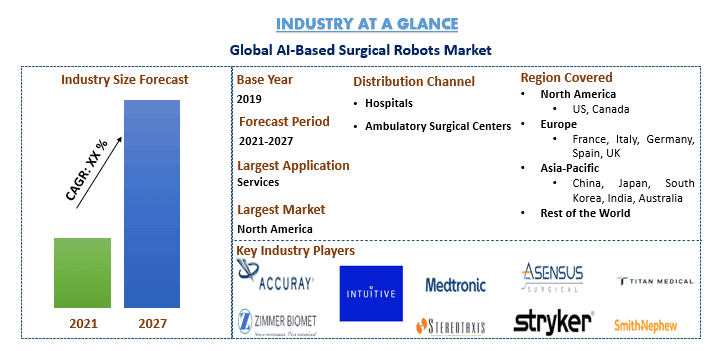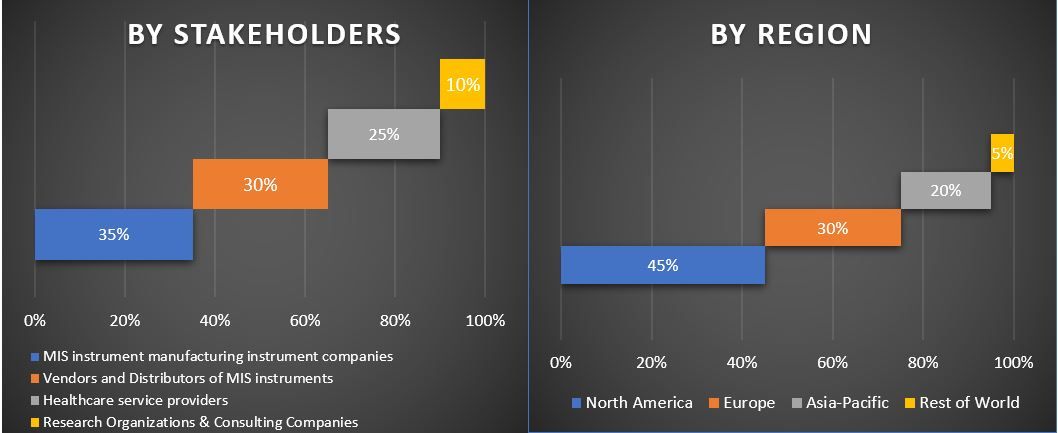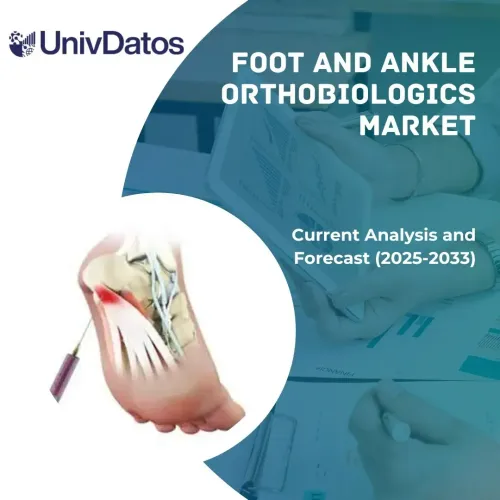- Strona główna
- O nas
- Branża
- Usługi
- Czytanie
- Kontakt
Rynek chirurgicznych robotów opartych na sztucznej inteligencji: aktualna analiza i prognoza (2021-2027)
Nacisk na rodzaj produktu (usługi, instrumenty, akcesoria), zastosowanie (ortopedia, neurologia, urologia, ginekologia, inne); użytkownik końcowy (szpitale, ambulatoryjne centra chirurgiczne); oraz region i kraj.

Wartość rynku robotów chirurgicznych opartych na sztucznej inteligencji wyniosła 5 miliardów USD w 2020 roku i oczekuje się, że w okresie prognozowania (2021-2027) wzrośnie przy CAGR na poziomie 17%. Operacje robotyczne zyskują na popularności ze względu na zwiększoną wydajność i wskaźnik sukcesu, jakie zapewniają te operacje, wraz z „minimalnie inwazyjnym” charakterem operacji. Zwiększyło to penetrację zaawansowanych technologii, takich jak sztuczna inteligencja, w dziedzinie operacji robotycznych, co pobudza wzrost rynku. Przejście od tradycyjnych praktyk procedur chirurgicznych do podejść opartych na sztucznej inteligencji przez pracowników służby zdrowia również napędza rynek robotów chirurgicznych opartych na sztucznej inteligencji. Obserwuje się wzrost popularności zaawansowanych technologicznie robotów do różnych zastosowań przez chirurgów.
Na przykład, zaawansowany technologicznie robot chirurgiczny Da Vinci jest wykorzystywany do różnych rodzajów operacji. Ponadto, w 2018 roku MAKO był używany do ponad 76 000 zabiegów wymiany kolana i biodra. Oczekuje się, że rosnąca popularność produktu do różnych zastosowań napędzi wzrost rynku robotów chirurgicznych opartych na sztucznej inteligencji w okresie prognozowania.
POPROŚ O BEZPŁATNY PRÓBNIK PDF
Rozszerzające się wykorzystanie technologii sztucznej inteligencji w systemach chirurgicznych wynika z jej zalet, które obejmują konsolidację baz danych i śródoperacyjną analizę wideo, co z kolei wspiera adopcję robotów chirurgicznych opartych na sztucznej inteligencji. Artykuł opublikowany w Annals of Surgery w 2018 roku stwierdzał, że sztuczna inteligencja okazała się korzystna we wspieraniu radiologów i chirurgów w zmniejszaniu wskaźnika lumpektomii o około 30% wśród pacjentek, u których wykonano biopsje igłowe piersi. Biopsje te uważano za zmiany o wysokim ryzyku, ale po chirurgicznym wycięciu okazały się łagodne. Stąd takie przypadki oznaczają korzystny charakter sztucznej inteligencji i pokrewnych technologii w procedurach chirurgicznych.
Przejście od tradycyjnych praktyk procedur chirurgicznych do podejść opartych na sztucznej inteligencji przez pracowników służby zdrowia również napędza rynek robotów chirurgicznych opartych na sztucznej inteligencji. Obserwuje się wzrost popularności zaawansowanych technologicznie robotów do różnych zastosowań przez chirurgów. Na przykład, zaawansowany technologicznie robot chirurgiczny Da Vinci jest wykorzystywany do różnych rodzajów operacji. Ponadto, w 2018 roku MAKO był używany do ponad 76 000 zabiegów wymiany kolana i biodra. Oczekuje się, że rosnąca popularność produktu do różnych zastosowań napędzi wzrost rynku robotów chirurgicznych opartych na sztucznej inteligencji w okresie prognozowania. Strategiczne inicjatywy, takie jak fuzje i przejęcia, wprowadzanie produktów na rynek, modernizacja technologii i partnerstwa, wdrażane przez kluczowych uczestników wskazują na pozytywny ruch na rynku robotów chirurgicznych opartych na sztucznej inteligencji.
W 2019 roku Medtronic wprowadził na rynek zaawansowaną technologicznie platformę chirurgiczną kręgosłupa wspomaganą robotem Mazor X Stealth. W tym samym roku Stryker Corporation ogłosił przejęcie Mobius Imaging i jej spółki zależnej Cardan Robotics. W 2020 roku Accuray Incorporated wprowadził na rynek zaawansowany technologicznie system CyberKnife S7, platformę CyberKnife następnej generacji. Oczekuje się, że te strategiczne inicjatywy kluczowych uczestników napędzą rynek robotów chirurgicznych opartych na sztucznej inteligencji w nadchodzących latach.
Analiza łańcucha wartości robotów chirurgicznych opartych na sztucznej inteligencji

Accuray Incorporated, Intuitive Surgical, Inc., Medtronic, plc, Medrobotics Corporation, Zimmer Biomet, Stereotaxis, Inc., TransEnterix, Inc. Asensus Inc., Stryker Corporation, Activ Surgical, Inc., Titan Medical, Inc., CMR Surgical, Inc., Smith and Nephew, itp., to niektórzy z czołowych graczy działających na globalnym rynku robotów chirurgicznych opartych na sztucznej inteligencji.
Informacje przedstawione w raporcie
„Spośród Rodzaju Produktu, segment usług ma największy udział”
Na podstawie rodzaju produktu segment usług zdominował rynek robotów chirurgicznych opartych na sztucznej inteligencji i odpowiadał za największy udział w przychodach wynoszący XX% w 2020 roku. Ten wysoki udział przypisuje się wyższym kosztom konserwacji związanym z algorytmami systemów chirurgii wspomaganej robotem. Ponadto, rutynowe modernizacje technologiczne i kompleksowe umowy serwisowe zapewniane klientom przez wiele firm dodatkowo zwiększają udział w przychodach.
„Spośród Zastosowań, segment Pozostałych zdominował rynek w okresie prognozowania”
Na podstawie zastosowania segment Pozostałych zdominował rynek robotów chirurgicznych opartych na sztucznej inteligencji i odpowiadał za największy udział w przychodach wynoszący XX% w 2020 roku. Pozostałe zastosowania obejmują głównie operacje ogólne, laparoskopię, okulistykę i operacje onkologiczne. Czynniki przyczyniające się do wysokiego udziału w przychodach segmentu obejmują rosnącą liczbę zabiegów chirurgicznych w obrębie jamy brzusznej i onkologicznych, w połączeniu z rosnącą częstością występowania raka piersi. Ponadto, rosnąca adopcja robotów do minimalnie inwazyjnych procedur laparoskopowych przez chirurgów dodatkowo oznacza wyższy udział.
„Spośród Użytkowników Końcowych, segment Szpitali zdominował rynek w okresie prognozowania.”
Na podstawie Użytkownika Końcowego rynek robotów chirurgicznych opartych na sztucznej inteligencji jest podzielony na Szpitale i Ambulatoryjne Centra Chirurgiczne. Segment Szpitali odpowiadał za największy udział w 2020 roku. Duży udział tego segmentu zastosowań można przypisać przede wszystkim rosnącej częstości występowania chorób cywilizacyjnych na całym świecie. Wiele szpitali zwraca się w stronę operacji wspomaganych robotem (RAS), aby zlikwidować zaległości w planowanych operacjach spowodowane przez COVID-19. Według konsultanta ds. chirurgii robotycznej i urologii w Indiach, od pierwszej fali pandemii wzrosła liczba pacjentów decydujących się na operacje robotyczne.
„Ameryka Północna reprezentuje jeden z największych rynków robotów chirurgicznych opartych na sztucznej inteligencji.”
Aby lepiej zrozumieć dynamikę rynku robotów chirurgicznych opartych na sztucznej inteligencji, przeprowadzono szczegółową analizę dla różnych regionów na całym świecie, w tym Ameryki Północnej (USA, Kanada i reszta Ameryki Północnej), Europy (Niemcy, Francja, Hiszpania, Wielka Brytania, Włochy i reszta Europy), Azji i Pacyfiku (Chiny, Japonia, Indie, Australia, Korea Południowa i reszta APAC), reszta świata. Ameryka Północna zdominowała rynek i wygenerowała przychody w wysokości XX milionów USD w 2020 roku ze względu na rosnący dochód na mieszkańca.
Powody, dla których warto kupić ten raport:
- Badanie obejmuje analizę wielkości rynku i prognozowanie, zweryfikowaną przez autentycznych kluczowych ekspertów branżowych
- Raport przedstawia szybki przegląd ogólnej wydajności branży na pierwszy rzut oka
- Raport obejmuje dogłębną analizę czołowych konkurentów z branży, z głównym naciskiem na kluczowe dane finansowe firmy, portfolio produktów, strategie ekspansji i najnowsze wydarzenia
- Szczegółowe badanie czynników napędzających, ograniczeń, kluczowych trendów i możliwości występujących w branży
- Badanie kompleksowo obejmuje rynek w różnych segmentach
- Dogłębna analiza branży na poziomie regionalnym
Opcje dostosowania:
Rynek robotów chirurgicznych opartych na sztucznej inteligencji można dodatkowo dostosować zgodnie z wymaganiami lub dowolnym innym segmentem rynku. Poza tym, UMI rozumie, że możesz mieć własne potrzeby biznesowe, dlatego skontaktuj się z nami, aby uzyskać raport, który w pełni odpowiada Twoim wymaganiom.
Spis treści
Analiza historycznego rynku, szacowanie obecnego rynku i prognozowanie przyszłego rynku globalnego rynku robotów chirurgicznych opartych na sztucznej inteligencji (AI) były trzema głównymi krokami podjętymi w celu stworzenia i analizy adopcji robotów chirurgicznych opartych na sztucznej inteligencji dla różnych operacji w głównych regionach na całym świecie. Przeprowadzono wyczerpujące badania wtórne w celu zebrania historycznych danych rynkowych i oszacowania obecnej wielkości rynku. Po drugie, aby zweryfikować te spostrzeżenia, wzięto pod uwagę liczne ustalenia i założenia. Ponadto przeprowadzono również wyczerpujące wywiady pierwotne z ekspertami branżowymi w całym łańcuchu wartości sektora robotów chirurgicznych opartych na sztucznej inteligencji. Po założeniu i walidacji danych rynkowych poprzez wywiady pierwotne, zastosowaliśmy podejście z góry na dół, aby prognozować całkowitą wielkość rynku. Następnie zastosowano metody podziału rynku i triangulacji danych w celu oszacowania i analizy wielkości rynku segmentów i podsegmentów, których dotyczy branża. Szczegółowa metodologia jest wyjaśniona poniżej:
Analiza historycznej wielkości rynku
Krok 1: Dogłębne badanie źródeł wtórnych:
Przeprowadzono szczegółowe badanie wtórne w celu uzyskania historycznej wielkości rynku robotów chirurgicznych opartych na sztucznej inteligencji za pośrednictwem wewnętrznych źródeł firmy, takich jak raport roczny i sprawozdania finansowe, prezentacje wyników, komunikaty prasowe itp. oraz źródeł zewnętrznych, w tym czasopism, wiadomości i artykułów, publikacji rządowych, publikacji konkurencji, raportów sektorowych, baz danych stron trzecich i innych wiarygodnych publikacji.
Krok 2: Segmentacja rynku:
Po uzyskaniu historycznej wielkości rynku robotów chirurgicznych opartych na sztucznej inteligencji przeprowadziliśmy szczegółową analizę wtórną w celu zebrania historycznych informacji o rynku i udziału dla różnych technologii i rodzajów sprzętu dla głównych regionów. Główne segmenty uwzględnione w raporcie to rodzaj produktu, zastosowanie, użytkownik końcowy i regiony. Przeprowadzono dalsze analizy na poziomie krajowym w celu oceny ogólnej adopcji robotów chirurgicznych opartych na sztucznej inteligencji w danym regionie.
Krok 3: Analiza czynnikowa:
Po uzyskaniu historycznej wielkości rynku różnych segmentów i podsegmentów przeprowadziliśmy szczegółową analizę czynnikową w celu oszacowania obecnej wielkości rynku robotów chirurgicznych opartych na sztucznej inteligencji. Ponadto przeprowadziliśmy analizę czynnikową przy użyciu zmiennych zależnych i niezależnych, takich jak rosnący popyt na roboty chirurgiczne oparte na sztucznej inteligencji. Przeprowadzono dokładną analizę scenariuszy popytu i podaży, biorąc pod uwagę najważniejsze partnerstwa, fuzje i przejęcia, ekspansję biznesową i wprowadzenie produktów na rynek w branży robotów chirurgicznych opartych na sztucznej inteligencji na całym świecie.
Obecne szacunki i prognozy dotyczące wielkości rynku
Obecne określenie wielkości rynku: Na podstawie użytecznych spostrzeżeń z powyższych 3 kroków doszliśmy do obecnej wielkości rynku, kluczowych graczy na rynku robotów chirurgicznych opartych na sztucznej inteligencji oraz udziałów w rynku segmentów. Wszystkie wymagane udziały procentowe i podziały rynku zostały określone przy użyciu wspomnianego powyżej podejścia wtórnego i zostały zweryfikowane poprzez wywiady pierwotne.
Szacowanie i prognozowanie: Do szacowania i prognozowania rynku przypisano wagę różnym czynnikom, w tym czynnikom napędzającym i trendom, ograniczeniom i możliwościom dostępnym dla interesariuszy. Po przeanalizowaniu tych czynników zastosowano odpowiednie techniki prognozowania, tj. podejście oddolne, aby dojść do prognozy rynkowej na około 2027 r. dla różnych segmentów i podsegmentów na głównych rynkach na całym świecie. Metodologia badawcza przyjęta do oszacowania wielkości rynku obejmuje:
- Wielkość rynku branży, pod względem wartości (USD) i stopę adopcji robotów chirurgicznych opartych na sztucznej inteligencji na głównych rynkach krajowych
- Wszystkie udziały procentowe, podziały i rozbicia segmentów i podsegmentów rynku
- Kluczowi gracze na rynku robotów chirurgicznych opartych na sztucznej inteligencji pod względem oferowanych usług. Ponadto strategie rozwoju przyjęte przez tych graczy w celu konkurowania na szybko rozwijającym się rynku
Walidacja wielkości i udziału w rynku
Badania pierwotne: Przeprowadzono dogłębne wywiady z kluczowymi liderami opinii (KOL), w tym z kadrą kierowniczą najwyższego szczebla (CXO/VPs, dyrektor ds. sprzedaży, dyrektor ds. marketingu, dyrektor operacyjny i dyrektor regionalny, dyrektor krajowy itp.) w głównych regionach. Następnie podsumowano wyniki badań pierwotnych i przeprowadzono analizę statystyczną w celu udowodnienia postawionej hipotezy. Dane z badań pierwotnych zostały skonsolidowane z wynikami badań wtórnych, przekształcając w ten sposób informacje w praktyczne spostrzeżenia.
Podział uczestników pierwotnych w różnych regionach
Inżynieria rynku
Zastosowano technikę triangulacji danych, aby ukończyć ogólne szacowanie rynku i uzyskać precyzyjne dane statystyczne każdego segmentu i podsegmentu rynku robotów chirurgicznych opartych na sztucznej inteligencji. Dane podzielono na kilka segmentów i podsegmentów po przestudiowaniu różnych parametrów i trendów w obszarach rodzaju i typu produktu na rynku robotów chirurgicznych opartych na sztucznej inteligencji.
Główny cel badania rynku robotów chirurgicznych opartych na sztucznej inteligencji
W badaniu wskazano obecne i przyszłe trendy rynkowe robotów chirurgicznych opartych na sztucznej inteligencji. Inwestorzy mogą uzyskać strategiczne informacje, aby oprzeć na nich swoje decyzje dotyczące inwestycji na podstawie analizy jakościowej i ilościowej przeprowadzonej w badaniu. Obecne i przyszłe trendy rynkowe określiły ogólną atrakcyjność rynku na poziomie regionalnym, zapewniając uczestnikom przemysłowym platformę do wykorzystania niezbadanego rynku, aby czerpać korzyści z przewagi pioniera. Inne ilościowe cele badań obejmują:
- Analiza obecnej i prognozowanej wielkości rynku robotów chirurgicznych opartych na sztucznej inteligencji pod względem wartości (USD). Ponadto analiza obecnej i prognozowanej wielkości rynku różnych segmentów i podsegmentów
- Segmenty w badaniu obejmują obszary zastosowania, rodzaj produktu i sektor użytkownika końcowego.
- Definiowanie i analiza ram regulacyjnych dla branży robotów chirurgicznych opartych na sztucznej inteligencji
- Analiza łańcucha wartości związanego z obecnością różnych pośredników, wraz z analizą zachowań klientów i konkurentów w branży
- Analiza obecnej i prognozowanej wielkości rynku robotów chirurgicznych opartych na sztucznej inteligencji dla głównego regionu.
- Główne regiony badane w raporcie to Ameryka Północna (USA i Kanada), Europa (Niemcy, Francja, Wielka Brytania, Hiszpania i Włochy), Azja i Pacyfik (Chiny, Japonia, Australia, Korea Południowa i Indie), Reszta świata
- Profile firm na rynku robotów chirurgicznych opartych na sztucznej inteligencji oraz strategie rozwoju przyjęte przez uczestników rynku w celu utrzymania się na szybko rozwijającym się rynku
- Dogłębna analiza branży na poziomie regionalnym
Powiązane Raporty
Klienci, którzy kupili ten przedmiot, kupili również











